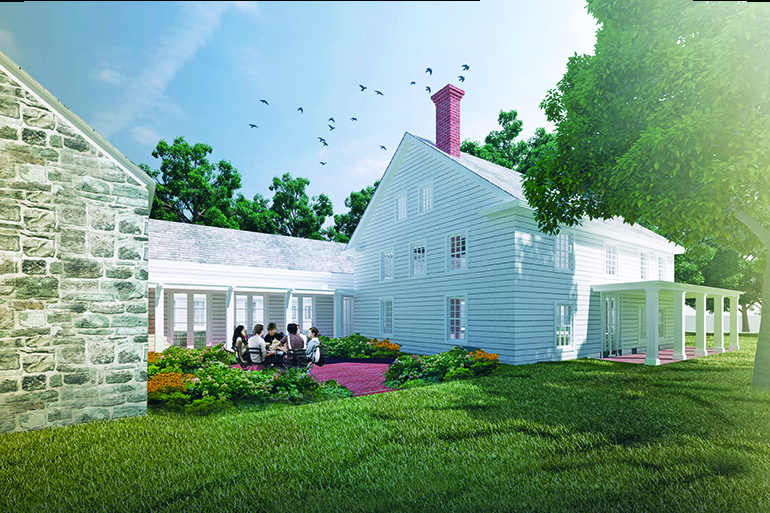Shelter Island Historical Society: Past, Present, Future

The history of Shelter Island is written in leaves, leather, Daguerreotypes, paint and porcelain, as well as in ink. Originally founded in 1922, the Shelter Island Historical Society’s mission is to “interpret Shelter Island’s past through historical material and through its people; from the first Native American inhabitants, settlers and town fathers, to those who have made it a unique community through the years.”

This mission will get a boost of 2,800 square feet of interior space with the opening of the Society’s new history center. Composed of a 425-square foot climate-controlled archival vault, as well as a study center, program space and offices, designed by William Pederson, the center is on track to be completed by Folkine Construction in early 2019. Certainly the project received the full support of recent Society President Elizabeth Pederson, wife of the architect. The work is now being spearheaded by Nanette W. Lawrenson, Executive Director of the Society and current Society President Janet D’Mato.
Lawrenson shares that “the grand opening will roll out through a series of events and exhibitions next summer.” But don’t wait until next year to visit the Historical Society’s headquarters. Support local farmers and craftspeople at the Havens Farmers Market on the Havens House Museum Grounds. It opens for the season on Saturday, May 26 and will be open every Saturday through September 1. While there, you can take a free tour of the construction sites with Lawrenson.

The expansion will fulfill the Society’s goal of offering year-round programming. It will also afford better storage for valuables, and will open up the areas of the Havens House that previously served as storage. Begun in 2016, the $3 million project has been funded through private donations from over 300 contributors.
Havens House, the original museum, is contemporaneously undergoing renewal. Its foundations have been stabilized and work is underway throughout the house. Until the work began, the whole of the Society’s collection was warehoused in its bedrooms and attic. The House is temporarily closed to the public, but Lawrenson says, “I love doing tours, people can’t believe how beautiful it is!”
The Society plans to further expand its existing collection, which already numbers over 100,000 maps, deeds, diaries, letters, photos and other historical documents, as well as artifacts such as artwork, furniture, tools, textiles, vehicles and housewares.

A 1652 Contract Articles of Agreement regarding ownership of Shelter Island and Robins Island is the oldest document in the collection. According to the Society’s Communications Coordinator Ebeth Lones, “European ownership of Shelter Island began when James Farrat, assigned to colonize Long Island by William Alexander, Earl of Stirling, received Shelter Island and Robins Island for his efforts. In 1641, Farratt sold both islands to Stephen Goodyear, deputy colonial governor. This document is the agreement between businessmen who subsequently purchased the island: Captain Thomas Middleton, Mr. Constant Silvester, Captain Nathaniel Sylvester and Ensign John Booth.”
The Society itself has quite a storied history. According to its records, “In all, the Society met only 50 times between November 1922 and August 1933. They collected important documents such as a Nut Bread recipe, Presbyterian Confessions of Faith and C.E. Record Book, notes from Lodowick Havens’s diary, five copies of The Shelter Island Tribune 1892-1893 and three copies of The Suffolk Times 1897-1927, among other items. [On] March 12, 1966: The Historical Society is formed…again!”
That nut bread recipe was later published in the Shelter Island Treasure of Personal Recipes, which was put out by the Shelter Island Presbyterian Church, and the original remains a treasured item in the collection.

Asked to offer a quintessential Shelter Island recipe in conjunction with Sylvester Manor, the Society and Sylvester Manor’s Director of Operations Tracy McCarthy hit on “a Wilted Lettuce Salad by Jean Brechter, who is a great and beloved member of the island.” This recipe appeared in the 2013 edition of The Shelter Island Historical Society Cookbook. McCarthy says, “It represents Shelter Island well, both from a historical perspective and the current farming and agriculture use at Sylvester Manor. This season, Sylvester Manor Educational Farm will have green onions, lettuce, radishes and eggs, as well as bacon from our own pigs.”
When pressed to choose her very favorite piece in the collection, Lawrenson considers “the beautiful gowns in the wardrobe collection,” but settles on the Havens House itself. As she says, the house and collection are “the soul of Shelter Island that blends and compliments the story.” She notes that once the Society made the decision to renew the Havens House itself, they uncovered locust ceiling beams, signatures inside the house and other “really interesting things.” She says she’s “most excited about opening the historic house and center at the same time—the original museum represents the past, the phenomenal center combines the present and the future!”
Shelter Island Historical Society, 16 South Ferry Road, Shelter Island, 631-749-0025, shelterislandhistorical.org. Sylvester Manor Educational Farm, 80 North Ferry Road, Shelter Island, 631-749-0626, sylvestermanor.org.



